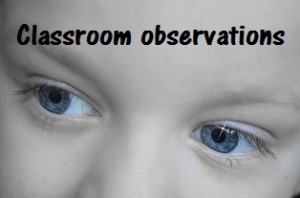Over the past few weeks, I have been into several schools/nurseries to observe children. It’s something speech and language therapists often do, especially at the assessment stage, but I can understand that it probably seems like a strange thing to spend a session doing, sitting and watching! So I thought today I’d write about what happens when I do an observation and why classroom (or sometimes playground) observations can be so useful.
A 1:1 clinic environment is an unnatural situation for anyone. Most real-life communication does not occur in a clinic room with a relative stranger. Therefore, while clinic sessions can be really useful in many ways, there is a lot missing from the picture of a child’s communication skills, if you only see them in this sort of environment. This is why an SLT is likely to spend as much time during the initial appointment talking to you about your child, as they do interacting with your child directly. For a child with speech sound problems, this is usually enough. However, sometimes, especially if the concerns are around comprehension (receptive language) or social communication, it can be useful to see a child in a more natural, everyday environment as well, to get a full picture of how they are communicating and how we can help.
Although staff will probably know the child really well, it’s unlikely that they’ve had time to really watch just that child without doing anything else. It can be very revealing – sometimes things are not as everyone thought.
So, do I go into a classroom or nursery and just sit unobtrusively in a corner and watch? Well, yes, for at least part of the time I do! I sit where I can see the child but not right next to them and very often they aren’t really aware that I’m there. I’m very subtle about who I’m watching and if children ask, I just tell them I’ve come to see what all the children in the class are doing. Here are some of the things I’m looking at while I’m watching:-
- Does the child initiate interaction with others (both adults and other children?) In other words, do they try to start a conversation? What do they do if they want or need something?
- Do they respond when people try to talk to them? If so, do they do this by speaking, looking, gesturing, a mixture?
- Are they able to sit in a group and listen at an age appropriate level?
- Do they follow instructions in the classroom? This is one that really needs to be watched carefully. Many children who struggle to understand have very sophisticated ways of covering this up. I’m watching to see if they watch what others are doing before carrying out the instruction, or look round the room for clues. Do they try to distract others to cover up the fact that they don’t understand? Is there a difference between how they follow instructions given to a whole group and instructions just given to them?
- Do people understand them when they try to communicate? If someone doesn’t understand then what do they do? Try again? Try a different way? Give up?
- Do they play with others? Are they part of the group or on the outside? Do they have their own play ideas or do they copy others? Do they stick with one thing or move around to various activities? Are they aware of what others are doing around them and can they share toys?
- If they are getting into trouble at school, what seems to be causing this? Are they finding it hard to sit and listen? Are there particular situations that they find difficult? Did someone else actually start it but the child could not explain this? Did they understand what they were asked to do? Are they confused by social rules?….. It can take a bit of unravelling sometimes but it’s really worth taking the time to do, as when we know exactly where the problem is, we can work out strategies to help.
I will always spend some time with the staff in the school or nursery when I go in as well. We talk about their view of the child’s communication and whether what I saw was a typical session or not. We talk about what strategies and activities they’ve tried to help the child’s communication and how it went. Did it help? If not, why not? Was it not the right strategy or did they just need to persevere a bit more or alter the strategy slightly?
Then we make a plan together of how to move forward. This is really important. Even if I’m lucky enough to be able to see the child regularly, I am only able to be there for a really small part of the week. Any strategy needs to be used every day, so everyone needs to work together – parents, school, me and anyone else who sees the child regularly.
Often a classroom or nursery observation can be one of the most useful things I can do. What do you find most useful about observation sessions?







I have always wondered what types of stuff a classroom observation person is looking for. It is good to know that one of those things is if the kids follow instructions. That is a great thing to be aware of when are a teacher.
Really informative; thank you for sharing this